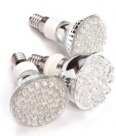Disadvantages of Solid State LEDs
Voltage sensitivity: LEDs must be supplied with the voltage above the threshold and a current below the rating. This can involve series resistors or current-regulated power supplies.
Light quality: Most cool-white LEDs have spectra that differ significantly from a black body radiator like the sun or an incandescent light.
The spike at 460 nm and dip at 500 nm can cause the color of objects to be perceived differently under cool-white LED illumination than sunlight or incandescent sources, due to metamerism, red surfaces being rendered particularly badly by typical phosphor based cool-white LEDs.
However, the color rendering properties of common fluorescent lamps are often inferior to what is now available in state-of-the-art white LEDs.
Area light source: LEDs do not approximate a “point source” of light, but rather a lambertian distribution. So LEDs are difficult to use in applications requiring a spherical light field. LEDs are not capable of providing divergence below a few degrees. This is contrasted with lasers, which can produce beams with divergences of 0.2 degrees or less.
Blue Hazard: There is increasing concern that blue LEDs and cool-white LEDs are now capable of exceeding safe limits of the so-called blue-light hazard as defined in eye safety specifications such as ANSI/IESNA RP-27.1-05: Recommended Practice for Photobiological Safety for Lamp and Lamp Systems.
Blue pollution: Because cool-white LEDs (i.e., LEDs with high color temperature) emit much more blue light than conventional outdoor light sources such as high-pressure sodium lamps.
The strong wavelength dependence of Rayleigh scattering means that cool-white LEDs can cause more light pollution than other light sources. It is therefore very important that cool-white LEDs are fully shielded when used outdoors.
Compared to low-pressure sodium lamps, which emit at 589.3 nm, the 460 nm emission spike of cool-white and blue LEDs is scattered about 2.7 times more by the Earth's atmosphere. Cool-white LEDs should not be used for outdoor lighting near astronomical observatories.
Light quality: Most cool-white LEDs have spectra that differ significantly from a black body radiator like the sun or an incandescent light.
The spike at 460 nm and dip at 500 nm can cause the color of objects to be perceived differently under cool-white LED illumination than sunlight or incandescent sources, due to metamerism, red surfaces being rendered particularly badly by typical phosphor based cool-white LEDs.
However, the color rendering properties of common fluorescent lamps are often inferior to what is now available in state-of-the-art white LEDs.
Area light source: LEDs do not approximate a “point source” of light, but rather a lambertian distribution. So LEDs are difficult to use in applications requiring a spherical light field. LEDs are not capable of providing divergence below a few degrees. This is contrasted with lasers, which can produce beams with divergences of 0.2 degrees or less.
Blue Hazard: There is increasing concern that blue LEDs and cool-white LEDs are now capable of exceeding safe limits of the so-called blue-light hazard as defined in eye safety specifications such as ANSI/IESNA RP-27.1-05: Recommended Practice for Photobiological Safety for Lamp and Lamp Systems.
Blue pollution: Because cool-white LEDs (i.e., LEDs with high color temperature) emit much more blue light than conventional outdoor light sources such as high-pressure sodium lamps.
The strong wavelength dependence of Rayleigh scattering means that cool-white LEDs can cause more light pollution than other light sources. It is therefore very important that cool-white LEDs are fully shielded when used outdoors.
Compared to low-pressure sodium lamps, which emit at 589.3 nm, the 460 nm emission spike of cool-white and blue LEDs is scattered about 2.7 times more by the Earth's atmosphere. Cool-white LEDs should not be used for outdoor lighting near astronomical observatories.
Electron Stimulated Luminescence (ESL™) Lighting Technology
Said to be the latest lighting technology to have come out of the labs is an
entirely new, energy efficient lighting technology.
It is neither incandescent, fluorescent nor LED.
ESL Lighting Technology uses accelerated electrons to stimulate phosphor to create light, making the surface of the bulb “glow”. ESL Technology creates the same light quality as an incandescent but is more energy conserving. There is no use of the neurotoxin Mercury (Hg) in the lighting process.
In creating ESL Technology, a merger of several existing and proven technologies was undertaken, then uniquely adapted them for “lighting”. It uses commonly sourced, non-hazardous, commercial materials that are customized to our specifications.
The ESL Technology is encased in light bulb glass which is sourced from existing light bulb glass manufacturers.
The manufacturers are currently developing a highly energy efficient, perfect light quality, mercury-free light bulb. Safe as a lighting source, the ESL Technology fits neatly into classic light bulb shapes familiar to consumers everywhere.
This eliminates the need to bend the technology into an unusual, twisted spiral shape (CFL) or have costly and heavy heat dissipation designed into the bulb housing (LED).
ESL Technology has a favorably small footprint beside the huge manufacturing and disposal costs footprints being generated by LED and CFL light bulb technology.
The Power of LUMINA Product Links
Standard Features of LUMINA
LM36x4
LM36x2
LM24x2 and LM18x2
LUMINA Electronic Signage Ballast
LED by LUMINA
LUMINA Efficacy
LUMINA Power Savings vs Others
LUMINA Power Consumption vs Others
Standard Features of LUMINA
LM36x4
LM36x2
LM24x2 and LM18x2
LUMINA Electronic Signage Ballast
LED by LUMINA
LUMINA Efficacy
LUMINA Power Savings vs Others
LUMINA Power Consumption vs Others
* Research information including images in this page were culled from internet resources and as such are copyrighted to their respective owners.



